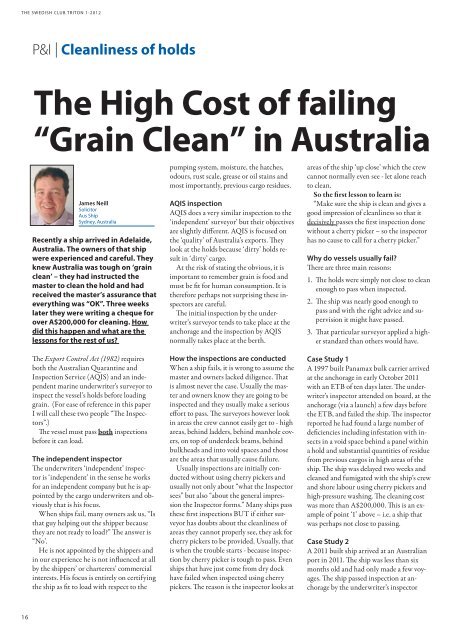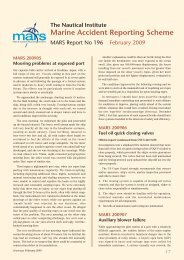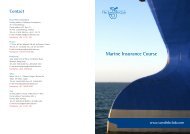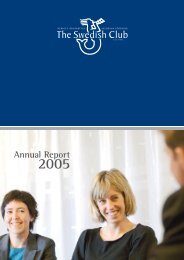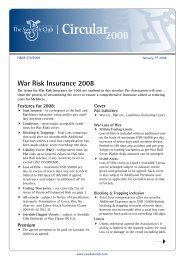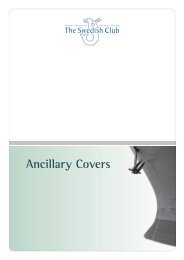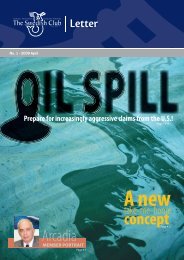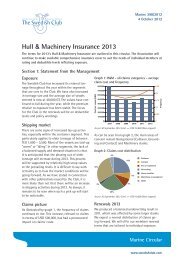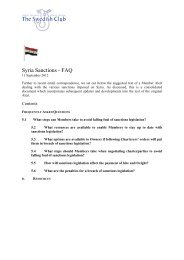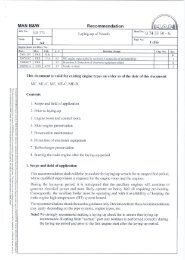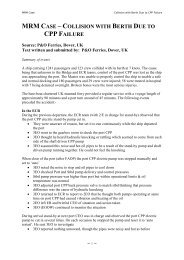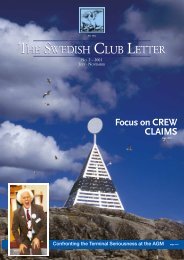TSC Triton no. 1 2012 - The Swedish Club
TSC Triton no. 1 2012 - The Swedish Club
TSC Triton no. 1 2012 - The Swedish Club
- No tags were found...
You also want an ePaper? Increase the reach of your titles
YUMPU automatically turns print PDFs into web optimized ePapers that Google loves.
THE SWEDISH CLUB TRITON 1-<strong>2012</strong>P&I | Cleanliness of holds<strong>The</strong> High Cost of failing“Grain Clean” in AustraliaJames NeillSolicitorAus ShipSydney, AustraliaRecently a ship arrived in Adelaide,Australia. <strong>The</strong> owners of that shipwere experienced and careful. <strong>The</strong>yknew Australia was tough on ‘grainclean’ – they had instructed themaster to clean the hold and hadreceived the master’s assurance thateverything was “OK”. Three weekslater they were writing a cheque forover A$200,000 for cleaning. Howdid this happen and what are thelessons for the rest of us?<strong>The</strong> Export Control Act (1982) requiresboth the Australian Quarantine andInspection Service (AQIS) and an independentmarine underwriter’s surveyor toinspect the vessel’s holds before loadinggrain. (For ease of reference in this paperI will call these two people “<strong>The</strong> Inspectors”.)<strong>The</strong> vessel must pass both inspectionsbefore it can load.<strong>The</strong> independent inspector<strong>The</strong> underwriters ‘independent’ inspectoris ‘independent’ in the sense he worksfor an independent company but he is appointedby the cargo underwriters and obviouslythat is his focus.When ships fail, many owners ask us, “Isthat guy helping out the shipper becausethey are <strong>no</strong>t ready to load?” <strong>The</strong> answer is“No’.He is <strong>no</strong>t appointed by the shippers andin our experience he is <strong>no</strong>t influenced at allby the shippers’ or charterers’ commercialinterests. His focus is entirely on certifyingthe ship as fit to load with respect to thepumping system, moisture, the hatches,odours, rust scale, grease or oil stains andmost importantly, previous cargo residues.AQIS inspectionAQIS does a very similar inspection to the‘independent’ surveyor’ but their objectivesare slightly different. AQIS is focused onthe ‘quality’ of Australia’s exports. <strong>The</strong>ylook at the holds because ‘dirty’ holds resultin ‘dirty’ cargo.At the risk of stating the obvious, it isimportant to remember grain is food andmust be fit for human consumption. It istherefore perhaps <strong>no</strong>t surprising these inspectorsare careful.<strong>The</strong> initial inspection by the underwriter’ssurveyor tends to take place at theanchorage and the inspection by AQIS<strong>no</strong>rmally takes place at the berth.How the inspections are conductedWhen a ship fails, it is wrong to assume themaster and owners lacked diligence. Thatis almost never the case. Usually the masterand owners k<strong>no</strong>w they are going to beinspected and they usually make a seriouseffort to pass. <strong>The</strong> surveyors however lookin areas the crew can<strong>no</strong>t easily get to - highareas, behind ladders, behind manhole covers,on top of underdeck beams, behindbulkheads and into void spaces and thoseare the areas that usually cause failure.Usually inspections are initially conductedwithout using cherry pickers andusually <strong>no</strong>t only about “what the Inspectorsees” but also “about the general impressionthe Inspector forms.” Many ships passthese first inspections BUT if either surveyorhas doubts about the cleanliness ofareas they can<strong>no</strong>t properly see, they ask forcherry pickers to be provided. Usually, thatis when the trouble starts - because inspectionby cherry picker is tough to pass. Evenships that have just come from dry dockhave failed when inspected using cherrypickers. <strong>The</strong> reason is the inspector looks atareas of the ship ‘up close’ which the crewcan<strong>no</strong>t <strong>no</strong>rmally even see - let alone reachto clean.So the first lesson to learn is:“Make sure the ship is clean and gives agood impression of cleanliness so that itdecisively passes the first inspection donewithout a cherry picker – so the inspectorhas <strong>no</strong> cause to call for a cherry picker.”Why do vessels usually fail?<strong>The</strong>re are three main reasons:1. <strong>The</strong> holds were simply <strong>no</strong>t close to cleane<strong>no</strong>ugh to pass when inspected.2. <strong>The</strong> ship was nearly good e<strong>no</strong>ugh topass and with the right advice and supervisionit might have passed.3. That particular surveyor applied a higherstandard than others would have.Case Study 1A 1997 built Panamax bulk carrier arrivedat the anchorage in early October 2011with an ETB of ten days later. <strong>The</strong> underwriter’sinspector attended on board, at theanchorage (via a launch) a few days beforethe ETB, and failed the ship. <strong>The</strong> inspectorreported he had found a large number ofdeficiencies including infestation with insectsin a void space behind a panel withina hold and substantial quantities of residuefrom previous cargos in high areas of theship. <strong>The</strong> ship was delayed two weeks andcleaned and fumigated with the ship’s crewand shore labour using cherry pickers andhigh-pressure washing. <strong>The</strong> cleaning costwas more than A$200,000. This is an exampleof point ‘1’ above – i.e. a ship thatwas perhaps <strong>no</strong>t close to passing.Case Study 2A 2011 built ship arrived at an Australianport in 2011. <strong>The</strong> ship was less than sixmonths old and had only made a few voyages.<strong>The</strong> ship passed inspection at anchorageby the underwriter’s inspector16


